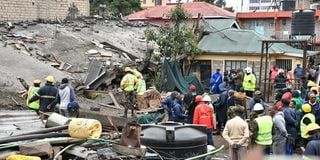Relocate capital city to put end to collapsing houses

Personnel from the Disaster Response Unit search for survivors in the Ruaka building collapse on November 17, 2022.
The rate at which storeyed houses are collapsing in Nairobi and its environs should be a wake-up to the authorities. In recent weeks, news of houses collapsing at Kasarani, Tassia, Ruaka and Ruiru, sometimes taking away innocent lives, is a matter of concern. It is time we took a long hard look into the perennial problem and came up with a sustainable solution to it.
I remember that sometime this year, Kenya Urban Roads Authority (Kura) published in the local dailies about its completed road projects. The list showed Kura did not build a single kilometre of road in Nyamira County. On the contrary, more than 1,200 kilometres of road were built in Nairobi.
Isn’t this one of the skewed development factors that is pushing people to the cities while abandoning the rural areas? No wonder the BBI proposed that Nairobi get 16 additional constituencies and Kiambu, the capital’s bedroom, six more MPs.
The rural-urban migration is happening at a rate the government cannot keep pace with. Everybody wants to migrate to Nairobi. That has made land in Nairobi and surrounding counties very expensive.
Obviously, the law of demand and supply for rental houses pushes developers to build multi-storeyed buildings even in areas where they are not supposed to go beyond one floor to accommodate the surging population.
The soil structure of Ruaka and the entire Kiambu County is red soil, which is ideal only for agriculture. But the skyline of Ruaka and, indeed, the entire Kiambu is dominated by highrise buildings, some going up to 20 floors.
Soil becomes loose
To add salt to injury, there is no sewer line in this place; hence, all the waste water from these multi-storeyed buildings is absorbed by the red soil. When it rains, the soil becomes loose, such that the ground cannot hold any more upcoming buildings. It was just a matter of time before the inevitable happened—like we are witnessing.
It’s the same case with Kasarani and Tassia. Previously, this was a grazing area for cattle, sheep and goats. Then it was discovered that the ground held precious building stones. The areas were, therefore, excavated many years ago to extract the building stones for the City of Nairobi.
When the brick stocks were depleted, the 100 or so deep quarries were refilled with soil and hardcore to give the impression that it was virgin land.
This was, in turn, sold to land-buying companies, which subdivided the land into small plots that they sold to unsuspecting developers. It is on these shaky grounds that 10-storey houses like the one that collapsed at Kasarani are built.
To ease pressure on the demand for houses in Nairobi and its environs, we should now think outside the box. We can shift the capital city from Nairobi. Isiolo or Laikipia counties, where there is vast land for future development, are ideal for a new capital.
Kenya will not be the first country in Africa to do that. Nigeria did it. Tanzania and South Africa, too. It will not be asking for too much.
Ms Kamau is a HR practitioner and author. [email protected].





